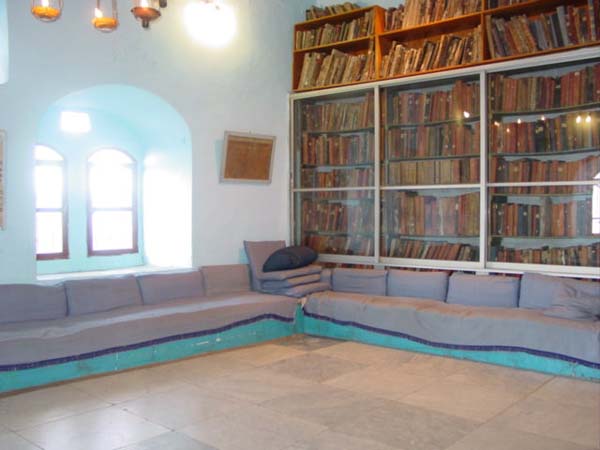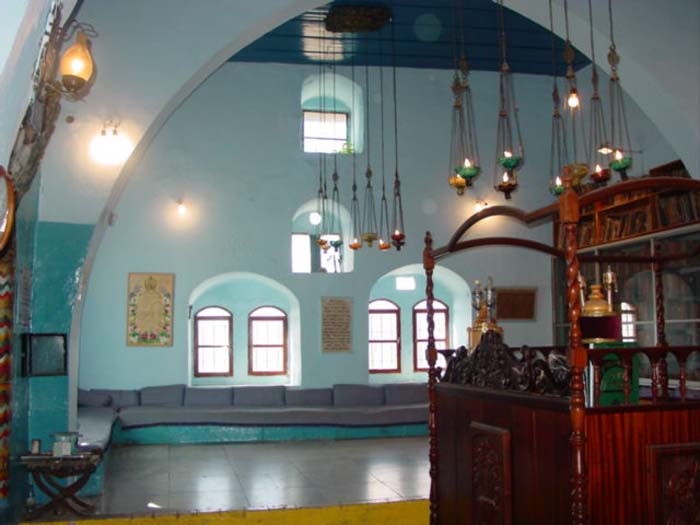by Chana Katz
RABBINICAL COURT
Although the synagogue of the saintly Rabbi Yosef Karo is used mostly for prayer and learning today, there was a time when it also served as the seat of one of the world’s most prestigious rabbinical courts.
The “step of honor” — a foot-or-so high step onto a platform — is the only telling sign today of the splendour of this “golden era” in Tzfat’s history. With a little imagination, however, one can picture Rabbi Karo — starting at age 48 — presiding on that platform as head of the Rabbinic Council.
The “lower” half of the synagogue — divided only by the platform and not by walls — was no less buzzing in activity. Besides serving as a House of Prayer, this half of the synagogue housed a prestigious learning center where hundreds of Torah students were drawn to the fiery depths of teaching permeating this city at the time.
Surrounded by some of the generation’s greatest Torah sages, R. Karo and his brilliant colleagues rendered Jewish legal decisions that were respected around the world.
This major Torah center was balanced by acts of kindness as well — around the corner from the synagogue one can still see the “soup kitchen” organized by R. Karo that provided nourishment for all of the area’s needy.
OLD SCROLLS AND BOOKS
Today’s visitor to this synagogue on Beis Yosef Street in the heart of Tzfat’s Old City, can view the collection of Torah books — “sefarim” — stacked high on the shelves of the back walls. Many are hundreds of years old, dating back at least to the mid-16th century when R. Karo composed the Shulchan Aruch, which became the universally accepted basic text of Jewish law from that time until today. Next to it is the geniza, the place for storing damaged holy books that are no longer usable until they can be given a proper burial.

Even the floor is interesting: no four blocks ever meet at one point. This was done intentionally in order to avoid forming a cross.
THE HOLY ARK
The Holy Ark is left open so that visitors can gaze and even take photographs. There are three Torah scrolls in the ark, behind secure bars. One is from Persia and is about 200 years old; one is from Iraq and is about 300 years old, and one is said to be from Spain and is over 500 years old.
TRACING HIS PATH
Upon entering the Karo synagogue, the arch above the door tells the story of its rededication in 1839 after Italian scholar and philanthropist R’ Yitzchak Goyatos unstintingly helped repair this, and other Tzfat synagogues devastated by the major earthquake of 1837.
Kissing the more than one-foot-high mezuzah (a showpiece itself) and passing through the arch, one can look at the wall to his left and see a map which traces R’ Karo’s journey before he settled in Tzfat; although various cities in Egypt, Turkey and Greece were stepping stones in R’ Karo’s life, it was his work in Tzfat — along with his contemporary, the Holy Ari, — which earned Tzfat the name it still bears today — one of Israel’s four Holy cities.
LIVING TORAH
While many of Tzfat’s ancient synagogues are closed today, except for weekend and holiday prayers, the Karo Synagogue is open most days from early morning until late at night. Daily minyans for morning, afternoon and evening services are held, as well as the holiday and Sabbath prayers. In addition, there is a “kollel” — where 16 young men learn Torah every evening, and a yeshivah for young students which is open in the mornings. The seating is around the periphery according to Sephardic custom, and there is a spectacular picture window view of Mount Meron to the west.
Even the original building with R. Karo’s soup kitchen has been put to modern use, providing free meals for the students who learn there. Right next to the soup kitchen (and underneath the synagogue) is the house where Karo learned and explored the Torah’s mysteries with some of Jewish history’s greatest luminaries.
NEW BIMA
Although the original bima — the elevated platform in the middle used for public reading of the Torah — was replaced by a larger one around forty years ago, and Goyotos imported new marble floor tiles from Italy, not much else has changed over the years in the Karo Synagogue.
Because the building was not designed to be a shul, the space available for the Women’s Section is not nearly sufficient. This lack is soon to be remedied, thanks to a generous grant from the well known philanthropist Nissim Gaon, given in honor of the five hundredth anniversary of Rabbi Yosef Caro’s birth in 1988.
THE CARETAKER
The family of the synagogue’s caretaker, Efrayim Ben Shimon, including his great-grandfather, HaRav Aaron ben Shimon, who was Tzfat’s chief Sephardic Rabbi in his time, has played a role in the Karo Synagogue since 1745 (although 200 members of his extended family were killed in the great earthquake).
Besides helping to organize the bustling daily prayer and study activities, Ben Shimon runs a store at the entranceway of the Karo Synagogue selling everything from Tzfat paintings to high-quality hand-made kippot.
While other historic Tzfat synagogues remain elusive for the unoriented visitor, those who do venture down Beit Yosef Street and into this synagogue, will most likely be met with open doors — as R’ Karo would have wanted.
Chana Katz, a former South Florida journalist, lives in Tsfat. Her articles on life in Israel have reached publications throughout the world.

